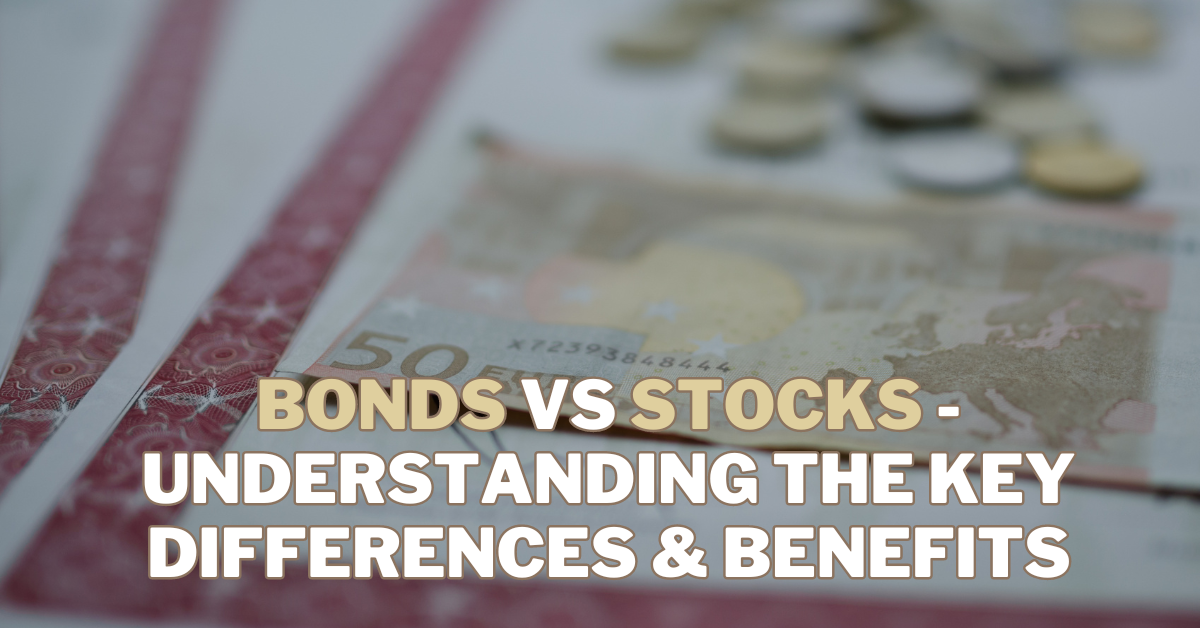Bonds Vs Stocks – Understanding The Key Differences

Bonds Vs Stocks – Understanding The Key Differences
Do you need help with the stability of bonds or the potential for growth with stocks? The eternal debate of bonds vs stocks has long captivated investors seeking to navigate the turbulent waters of financial markets.
Like Yin and Yang, these two investment vehicles have differing risks and advantages, making them attractive to various investors based on their financial objectives and risk tolerance.
Bonds exude a sense of security, like a dependable old friend who never lets you down, while stocks beckon with promises of thrilling highs and stomach-churning lows akin to a rollercoaster ride through Wall Street.
This article delves into the heart of this age-old dilemma, exploring the critical differences between bonds and stocks to help you make informed decisions in your investment journey.

What Are Bonds?
Debt instruments, known as bonds, are issued by businesses, governments, municipalities, and other organizations to generate money.
When investors buy a bond, they are lending the issuer money in return for periodic interest payments over a certain length of time.
Bonds offer a fixed income with a defined maturity date, in contrast to stocks, which represent ownership in a firm and may yield dividends and capital gain.
Want to Start Making Money Online?
Try My #1 Recommendation Program!
Because of their relative stability and predictable returns, investing in bonds might be considered more conservative than in stocks.
Bonds are crucial to diversified investment portfolios, allowing investors to balance risk and return.
As interest rates fluctuate, so do bond prices; therefore, understanding the relationship between interest rates and bond prices is essential for investors looking to optimize their investment strategies.

Types Of Bonds
Regarding investing, bonds are popular for those seeking more portfolio stability. Several types of bonds are available, each offering unique features and risks.
The safest choice is US government-issued Treasury bonds, although investors can benefit from the tax advantages of municipal bonds.
Corporate bonds provide higher yields but come with greater risk depending on the issuing company's financial health.
Convertible bonds are another intriguing option allowing investors to exchange their bonds for shares of the issuing company's stock at a set price.
This offers potential upside if the company performs well in the future. Inflation-linked bonds are another option.
They act as a hedge against growing prices by modifying their interest payments in response to variations in inflation rates.
Understanding these different types of bonds can help investors diversify their portfolios effectively and manage risk better in fluctuating market conditions.
Key Characteristics Of Bonds
Bonds are known for their key characteristics that differentiate them from stocks.
Risk Of Investment In Bonds
Investing inherently involves risk, whether in bonds or stocks. Although bonds are typically perceived as less risky than stocks because of their fixed income and superior priority in bankruptcy scenarios, they still bear inherent risks.
Bonds may face interest rate, credit, and inflation risks, which can influence their value and yields. Conversely, stocks may have greater returns but entail increased volatility and market uncertainty.
The degree of risk a person will assume is contingent upon their investment objectives and time frame.
Want to Find Out How To Start Your Home-Based Business?
Try My #1 Recommendation Platform!
Typically, younger investors exhibit a greater tolerance for risk, leading them to allocate a larger portion of their investments toward stocks to capitalize on long-term growth opportunities.
Conversely, individuals nearing retirement often prioritize the stability bonds offer to safeguard their capital and secure consistent income.
Recognizing and assessing one's risk appetite is crucial for establishing a diversified investment portfolio that reflects their financial goals.

Return On Investment Of Bonds
Return on investment is an important factor when choosing bonds vs. stocks. While stocks generally offer higher potential returns, they also come with higher risk.
On the other hand, bonds provide more stable returns but at lower rates than stocks. When choosing between the two, investors must evaluate their risk tolerance and financial goals.
The return from bonds is typically in the form of interest payments and the principal amount at maturity, whereas stock returns come from capital appreciation and dividends.
This variation may impact the success of an investor's portfolio in return generation. While some investors are content to take on greater risk in exchange for larger stock returns, others prefer the consistent income that bonds provide.
Income From Investments In Bonds
Income from investments is a crucial aspect to consider when comparing bonds vs stocks. Bonds typically provide a fixed income stream in interest payments, making them a more stable choice for investors seeking predictable returns.
On the other hand, stocks offer income in dividends, which can fluctuate based on company performance.
This variability introduces risk and the potential for higher returns, appealing to those willing to take on more uncertainty.
An investor's risk tolerance and financial objectives ultimately choose between bonds and equities.
Cautious investors frequently favour bonds, seeking steady income streams, while investors seeking long-term gains may select stocks.
It's important to carefully assess your financial situation and investment objectives before deciding where to allocate your funds for optimal income generation.
Understanding the implications of both asset classes on your income portfolio allows you to create a diversified strategy that balances stability with growth opportunities.

How Do You Make Money With Bonds?
Bonds can be a lucrative way to make money by earning interest payments over time. One strategy is to buy and hold bonds until maturity, allowing you to receive the bond's total face value and periodic interest payments.
Another approach is to invest in high-yield bonds with higher interest rates but more significant risk.
Diversifying your bond portfolio across different types, such as government, corporate, and municipal bonds, can also help maximize returns while effectively managing risks.
Moreover, secondary market bond trading allows investors to profit through strategic buying and selling influenced by market trends.
Keeping abreast of economic developments, interest rate fluctuations, and bond issuer credit ratings empowers investors to make astute choices and seize advantageous positions in the bond market.
Acquiring a comprehensive comprehension of bond investment dynamics and crafting a carefully devised strategy aligned with individual financial objectives lays the groundwork for a prosperous foray into bond profitability.
How Do You Buy Bonds?
Bonds can be attractive for investors seeking lower risk than stocks. Individuals can explore various avenues to buy bonds, such as purchasing directly from the government through Treasury bonds or acquiring corporate bonds through brokers or financial institutions.
Before making a purchase decision, factors like bond maturity, interest rates, and credit ratings must be considered.
Investors looking to buy bonds should also carefully evaluate their risk tolerance and investment goals.
Diversifying a bond portfolio across different issuers and sectors can help spread risk and enhance overall stability.
Additionally, staying informed about economic indicators and market trends can aid in making informed decisions when buying bonds.
By following these guidelines, investors can navigate the bond market effectively and build a balanced investment strategy that aligns with their financial objectives.

What Are Stocks?
Equities, or shares or stocks, are ownership stakes in a business. Purchasing a stock enables you to become a shareholder and own a tiny portion of the company.
This ownership entitles you to partake in the company's profits through dividends and benefit from any increase in the stock price.
One key characteristic of stocks is their volatility. Unlike bonds, which offer steady interest payments over time, stocks can experience significant price fluctuations due to market conditions, economic trends, and company performance.
Are You Tired Of Scams?
Try The Most-Trusted Training Platform To Make Money Online!
Though some investors may find this volatility frightening, there are chances for larger profits compared to more steady investing alternatives.
Understanding stocks involves researching and analyzing companies to make informed investment decisions.
Examining financial data, industry trends, and market circumstances can help investors evaluate the risks and returns of investing in certain stocks more accurately.
Ultimately, investing in stocks requires a long-term perspective and the willingness to ride out market fluctuations to earn significant returns over time.

Types Of Stocks
Various criteria categorize stocks into different types, with standard classifications including blue-chip stocks, growth stocks, value stocks, and dividend stocks.
Blue-chip stocks are typically large, established companies with a history of stable performance. Due to their track record and steady dividends, they are considered safe investments.
Growth stocks represent companies investors expect to grow faster than the overall market. These stocks often prioritize reinvesting profits for expansion rather than paying out dividends.
Value stocks, on the contrary, are considered undervalued in terms of their price compared to their intrinsic value. Investors seek these opportunities, expecting potential increases as the market corrects its pricing.
Moreover, dividend stocks offer regular income through payouts from companies' profits. Investors looking for capital appreciation and recurring income often favour dividend-yielding shares as part of their portfolio mix.
Each type of stock has its own set of risks and potential rewards, depending on an investor's investment objectives and risk tolerance.
Key Characteristics Of Stocks
Because of the fundamental qualities that differentiate stocks from other asset classes, they are a well-liked investment option.
Risk Of Investing In Stocks
Risk level is a crucial consideration when comparing bonds to stocks. Bonds typically entail lower risk than stocks due to their fixed interest payments and reduced volatility. Many investors seeking stable returns opt for bonds as a safer investment alternative.
Nevertheless, it is imperative to acknowledge that lower risk might translate to lower returns. Conversely, stocks present higher growth prospects alongside heightened risk and volatility.
Investors must meticulously evaluate their risk tolerance and investment objectives before choosing between bonds and stocks.
Comprehending and effectively managing risk is pivotal in constructing a diversified investment portfolio that aligns with one's financial goals.
By balancing the risks associated with both asset classes, investors can devise a strategy to maximize returns while mitigating potential losses.

Return On Investment From Stocks
Return stands as a critical attribute of stocks, closely monitored by investors. It signifies the profit or loss from owning a specific stock within a defined timeframe.
Investors commonly assess a stock's historical returns to appraise its performance and potential for future growth.
Recognizing the correlation between risk and return is paramount in stock investment, as elevated returns usually accompany greater levels of risk.
An important aspect of return to consider is the total return concept, which includes both capital gains (or losses) from changes in stock price and dividends received.
Investors should also assess their investment goals and risk tolerance before deciding on an appropriate stock mix based on expected returns for their portfolio.
In today's dynamic market environment, staying informed about market trends and economic factors can help investors make more informed decisions and achieve better investment returns.

Growth Stocks
The potential for high earnings growth in the future characterizes growth stocks. Rather than distributing dividends to shareholders, these businesses usually reinvest their profits back into the company to support innovation and growth.
Growth stocks attract investors for their ability to outperform the market and deliver above-average returns over time.
These companies often operate in rapidly growing industries or have a unique competitive advantage that allows them to capture market share.
One key characteristic of growth stocks is their focus on research and development, leading to new product offerings and technological advancements.
These companies' ongoing innovation enables them to maintain a competitive edge and adjust to evolving market dynamics.
Want To Learn How To Create Your Own Website And Online Business?
Try My #1 Recommendation Training And Hosting Platform!
Moreover, growth stocks typically exhibit higher price-to-earnings ratios than value stocks, indicating investors' optimism regarding future earnings prospects.
In summary, investing in growth stocks demands a long-term outlook and a willingness to withstand volatility, as these companies may encounter fluctuations in their stock prices while offering the potential for substantial capital appreciation in the long run.
Risk Tolerance When Investing In Stocks
When investing in stocks, it is essential to consider your risk tolerance. Knowing your comfort level with risk can guide your choice of stocks and align them with your investment objectives. Investors with a high-risk tolerance may lean towards investing in volatile, high-growth stocks.
On the other hand, those who can tolerate less risk could choose dividend-paying, reliable businesses. Knowing your risk tolerance is essential to make wise stock market investments.
Assessing your risk tolerance and creating an investment strategy that reflects this fundamental characteristic is necessary.
By knowing how much volatility you can handle, you can better navigate the stock market's ups and downs without succumbing to emotional decision-making.
Remember that risk tolerance is not static and may change over time based on various factors such as financial goals, life events, or market conditions.
Flexibility in adjusting your portfolio according to your evolving risk appetite is crucial for long-term investment success.
How To Buy Stocks?
Find businesses that share your beliefs and investing objectives first.
To make informed decisions, look into their financial health, prospects, and industry trends. Utilize resources like stock market analysis tools, financial news sources, and expert opinions to guide your choices.
Before purchasing stocks, consider setting a budget and diversifying your portfolio to spread risk. Determining how much you're willing to invest and creating a strategy that suits your risk tolerance is crucial. Watch market swings and be ready for stock price ups and downs.
Regarding stock market investment, patience is essential; steer clear of rash choices based on transient swings.
Remember that patience is critical when investing in the stock market; avoid making impulsive decisions based on short-term fluctuations.
Do you need help with the stability of bonds or the potential for growth with stocks?
The eternal debate of bonds vs stocks has long captivated investors seeking to navigate the turbulent waters of financial markets.
Like Yin and Yang, these two investment vehicles have differing risks and advantages, making them attractive to various investors based on their financial objectives and risk tolerance.
Bonds exude a sense of security, like a dependable old friend who never lets you down, while stocks beckon with promises of thrilling highs and stomach-churning lows akin to a rollercoaster ride through Wall Street.
This article delves into the heart of this age-old dilemma, exploring the critical differences between bonds and stocks to help you make informed decisions in your investment journey.

Stocks vs Bonds – Which Is The Suitable Investment?
When choosing between stocks and bonds, investors often find themselves at a crossroads with differing opinions on the right investment strategy.
Bonds offer stability and predictability in returns, making them a popular choice for risk-averse individuals looking for steady income streams.
However, stocks possess the potential for greater returns over extended periods owing to their growth opportunities and dividend distributions.
When considering stocks versus bonds, one crucial aspect revolves around your risk tolerance and investment horizon.
Stocks inherently exhibit more volatility but can yield substantial returns when held for prolonged durations.
In contrast, bonds are more adept at safeguarding capital and generating consistent income in the short term.
Balancing these two asset classes based on your financial objectives and risk appetite is pivotal in crafting a comprehensive investment portfolio tailored to your unique circumstances.
It is imperative to emphasize diversification in managing risk within your investment portfolio.
Spreading your assets throughout various asset types, such as bonds and equities, will lessen the effect of a single market collapse on your total wealth.
Moreover, maintaining alignment with your goals requires routinely reviewing and modifying your portfolio in response to changing market conditions and individual circumstances.
Seeking counsel from a financial advisor can offer invaluable insights and assistance in devising a diversified investment strategy tailored to your specific requirements.
Dedicate time to educate yourself about diverse investment opportunities and methodologies to make informed decisions conducive to achieving long-term financial prosperity.
Conclusion
Whether to invest in stocks or bonds ultimately depends on personal tastes, risk tolerance, and financial goals.
Stocks provide the potential for longer-term, larger gains, while bonds provide stability and a guaranteed income.
Investors must diversify their portfolios over various asset types to minimize risk and maximize possible returns.
Understanding the distinctions between bonds and stocks enables investors to make educated choices aligned with their investment goals.
Whether opting for bonds or stocks, it's essential to regularly evaluate your investment strategy and seek guidance from a financial advisor to ensure a well-rounded portfolio tailored to your requirements.
I trust you enjoyed this article on Bonds vs Stocks—Understanding The Key Differences. Please stay tuned for more articles to come soon. Take care!
JeannetteZ
Want to Learn How to Build Your Own Home-Based Online Business & Start Making Money Online From Your Comfortable Couch?
Try Wealthy Affiliate!
Your Opinion Is Important To Me
Do you have thoughts, ideas, or questions? I would love to hear from you. Please leave me your questions, experiences, remarks, and suggestions about Bonds vs Stocks—Understanding The Key Differences in the comments below. You can also email me at Jeannette@WorkFromAnywhereInTheWorld.com.
Disclosure
This post may contain affiliate links. I earn from qualifying purchases as an Amazon Associate and other affiliate programs. Please read my full affiliate disclosure.
You may also enjoy the following articles:
How To Start Investing In Stocks – A Beginner's Guide







